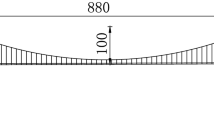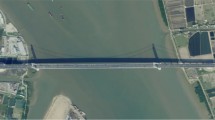Abstract
The steel bridge deck undergoes significant temperature changes during the high-temperature paving of asphalt pavement, and the non-uniform thermal field distribution herein affects the performance of pavement composite system. In this paper, the thermal field characteristic of the steel bridge deck during asphalt pavement paving was presented based on in-situ monitoring of the Tongling Yangtze River Bridge (TL Bridge) and numerical simulation. Firstly, the monitoring schemes were proposed to monitor the temperature changes of the steel bridge deck during the paving process, and the 3-D temperature distribution of the steel bridge deck was summarized. Secondly, a thermal field model of steel box girder was established according to the transient temperature field theory, and the element deletion method was used to simulate the process of paving construction. Subsequently, the thermal field model was validated by the monitoring results. Thirdly, the validated thermal field model was used to evaluate the sensitive factors that could affect the temperature distribution of the steel bridge deck during asphalt pavement paving. Finally, the critical temperature load formula was fitted, in which the sensitive factors were considered by introducing sensitive parameters.
Similar content being viewed by others
References
BS 5400-2 (1978). British standard, Steel, concrete and composite bridges (Part 2: Specification for loads), Board of BSI, London.
Cho, S., Kikuchi, K., and Kawasaki, A. (2012). “On the role of amorphous intergranular and interfacial layers in the thermal conductivity of a multi-walled carbon nanotube-copper matrix composite.” Acta Materialia, Vol. 60, No. 2, pp. 726–736, DOI: 10.1016/j.actamat.2011.09.056.
Dilger, W., Ghali, A., Chan, M., Cheung, M., and Maes, M. (1983). “Temperature stresses in composite box girder bridges.” Journal of Structural Engineering, ASCE, Vol. 109, No. 6, pp. 1460–1478, DOI: 10.1061/(ASCE)0733-9445(1983)109:6(1460).
Ding, Y. L., Zhou, G. D., Li, A. Q., and Wang, G. X. (2012). “Thermal field characteristic analysis of steel box girder based on long-term measurement data.” International Journal of Steel Structures, Vol. 12, No. 2, pp. 219–232, DOI: 10.1007/s13296-012-2006-x.
Gong, F., Bui, K., Papavassiliou, D. V., and Duong, H. M.(2014). “Thermal transport phenomena and limitations in heterogeneous polymer composites containing carbon nanotubes and inorganic nanoparticles.” CARBON, Vol. 78, pp. 305–316, DOI: 10.1016/j.carbon.2014.07.007.
Kim, S. H., Cho, K. I., Won, J. H., and Kim, J. H. (2009). “A study on thermal behaviour of curved steel box girder bridges considering solar radiation.” Archives of Civil and Mechanical Engineering, Vol. 9, No. 3, pp. 59–76, DOI: 10.1016/S1644-9665(12)60218-0.
Kong, B., Cai, C., and Pan, F. (2014). “Thermal field distributions of girder bridges with GFRP panel deck versus Concrete Deck.” Journal of Bridge Engineering, ASCE, Vol. 19, No. 11, 04014046, DOI: 10.1061/(ASCE)BE.1943-5592.0000617.
Li, H. and Harvey, J. (2010). “Numerical simulation and sensitivity analysis of asphalt pavement temperature and near-surface air temperature using integrated local modeling.” The 90th Annual Meeting of the Transportation Research Board, Washington, DC, pp 3111–3125.
Park, S. and Kim, Y. (1998). “Analysis of layered viscoelastic system with transient temperatures.” Journal of Engineering Mechanics, Vol. 124, No. 2, pp. 223–231, DOI: 10.1061/(ASCE)0733-9399(1998)124:2(223).
Qian, Z., and Liu Yan. (2012). “Mechanical analysis of waterproof bonding layer on steel bridge deck under bridge-temperature-load coupling effect.” Journal of Southeast University: Natural Science Edition, Vol. 42, No. 4, pp. 729–733, DOI: 10.3969/j.issn.1001-0505.2012.04.029. (in Chinese)
Rajbongshi, P. and Das, A. (2009). “Estimation of temperature stress and low-temperature crack spacing in asphalt pavements.” Journal of Transportation Engineering, ASCE, Vol. 135, No. 10, pp. 745–752, DOI: 10.1061/(ASCE)TE.1943-5436.0000050.
Rodriguez, L., Barr, P., and Halling, M. (2014). “Temperature effects on a Box-Girder Integral-Abutment Bridge.” Journal of Performance of Constructed Facilities, ASCE, Vol. 28, No. 3, pp. 583–591, DOI: 10.1061/(ASCE)CF.1943-5509.0000437.
Tong, M., Tham, L. G., Au, F. T. K., and Lee, P. K. K. (2001). “Numerical modeling for temperature distribution in steel bridges.” Computers & Structures, Vol. 79, No. 6, pp. 583–593, DOI: 10.1016/S0045-7949(00)00161-9.
Wang, J., Chen, Y., and Min, Q. (2007). “Research on characters of solar radiation in Suzhou area.” Journal of Suzhou University (Engineering Science Edition), Vol. 27, No. 2, pp. 55–57, DOI: 10.3969/j.issn.1673-047X.2007.02.015. (in Chinese)
Wang, W., **e, J., Liu, Z., and Miao, L. (2002). “3-D Transient temperature field analysis and calculation for brake disc with cyclic symmetric structure.” Chinese Journal of Mechanical Engineering, Vol. 38, No. 12, pp. 131–134, DOI: 10.3901/JME. 2002.12.131. (in Chinese)
Webb, G. T., Vardanega, P. J., Fidler, P. R. A., and Middleton, C. R. (2014). “Analysis of structural health monitoring data from Hammersmith Flyover.” Journal of Bridge Engineering, ASCE, Vol. 19, No. 6, 05014003, DOI: 10.1061/(ASCE)BE.1943-5592.0000587.
Yong, X., Bo, C., **ao-qing, Z., and You-lin, X. (2013). “Field monitoring and numerical analysis of Tsing Ma Suspension Bridge temperature behavior.” Structural Control and Health Monitoring, Vol. 20, No. 4, pp. 560–575, DOI: 10.1002/stc.515.
Yun, Y.-W. and Jang, I.-Y. (2008). “Research on early age deformation of high performance concrete by fiber bragg grating sensor.” KSCE Journal of Civil Engineering, KSCE, Vol. 12, No. 5, pp. 323–328, DOI: 10.1007/s12205-008-0323-6
Author information
Authors and Affiliations
Corresponding author
Rights and permissions
About this article
Cite this article
Liu, Y., Qian, Z. & Hu, H. Thermal field characteristic analysis of steel bridge deck during high-temperature asphalt pavement paving. KSCE J Civ Eng 20, 2811–2821 (2016). https://doi.org/10.1007/s12205-016-0027-2
Received:
Revised:
Accepted:
Published:
Issue Date:
DOI: https://doi.org/10.1007/s12205-016-0027-2




